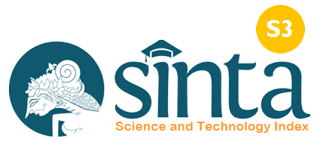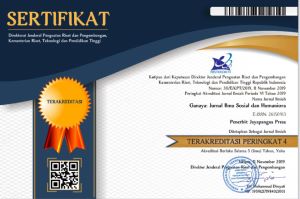Buku Fotografi Tari Lengger Lanang
Media Pembelajaran Berbasis Visual untuk Pendidikan Seni dan Budaya
DOI:
https://doi.org/10.37329/cetta.v8i4.4877Keywords:
Banyumas, dance arts, Lengger Lanang, photography novelAbstract
Lengger Lanang is a traditional Banyumas dance art whose existence is threatened by changes in public perception. This art, which originally functioned as a ritual for Dewi Sri and even a war tactic during the Diponegoro era, has experienced a shift in values due to the stigma against cross-gender culture. This study aims to design educational media to preserve Lengger Lanang by providing an in-depth perspective on the history and lives of its dancers. The study uses a descriptive qualitative approach with creative methods. Data collection was carried out through literature studies, observations, and in-depth interviews with Lengger Lanang dancers. Data were analyzed thematically to identify key narratives. The results show that the philosophical values of Lengger Lanang are far deeper than just a cross-gender performance. Three main narratives were identified: (1) spirituality and its relationship to agriculture, (2) heroism and cultural strategies in fighting colonialism, and (3) the struggle for identity and dedication of Lengger Lanang dancers who maintain tradition. These narratives were then realized in the design of a photographic novel book that combines strong visuals with narrative text. The photographic novel book has proven effective as a strategic medium for educating the public. This media successfully shifted the focus from gender stigma to an appreciation of the historical, artistic, and human interest values behind the Lengger Lanang mask. The study's conclusions recommend the use of a narrative-based creative design approach to preserve other intangible cultural heritage.
References
Aprilia, R. (2021). Eksistensi Lengger Lanang Langgeng Sari Banyumas. Imaji: Jurnal Seni dan Pendidikan Seni, 19(1), 1–7.
Ardianto, E. (2019). Metode penelitian untuk public relations kualitatif. Bandung: Simbiosa Rekatama Media.
Asamoah-Poku, F. (2024). Preserving Traditional Ghanaian Folklore Through Storytelling. European Modern Studies Journal, 8(2), 308–318.
Azoulay, A. (2010). What Is a Photograph? What Is Photography? Philosophy of Photography, 1(1), 9–13.
Baharuddin, N., Rosli, H., & Juhan, M. S. (2023). The Creative Process: Developing Visual Storytelling Through Design Thinking. International Journal of Academic Research in Business and Social Sciences, 13, 2113–2119.
Bohnsack, R. (2008). The Interpretation of Pictures and the Documentary Method. Forum Qualitative Sozialforschung / Forum: Qualitative Social Research, 9(3).
Braun, V., & Clarke, V. (2006). Using Thematic Analysis in Psychology. Qualitative Research in Psychology, 3(2), 77–101.
Bryman, A. (2016). Social research methods (5th ed.). Oxford: Oxford University Press.
Cahyadi, E., & Aryani, D. I. (2025). Teaching Kids Fruit and Veggie Benefits Through Media Book Design. Equilibrium: Jurnal Pendidikan, 13(2), 150–163.
Caton, L. (2019). Gillian Rose, Visual Methodologies: An Introduction to Researching With Visual Materials. Journal of Early Childhood Literacy, 0(0).
Creswell, J. W., & Creswell, J. D. (2017). Research design: Qualitative, Quantitative, and Mixed Methods Approaches. Newbury Park: Sage Publications.
Economou, M. (2015). Heritage in the Digital Age. In A Companion to Heritage Studies. New Jersey: John Wiley & Sons, Inc.
Emerson, R. M., Fretz, R. I., & Shaw, L. L. (2011). Writing ethnographic fieldnotes (2nd ed.). Chicago: University of Chicago Press.
Hartanto, S. I. (2016). Perspektif Gender Pada Lengger Lanang Banyumas. PANTUN: Jurnal Ilmiah Seni Budaya, 1(2), 145–153.
Hobsbawm, E., & Ranger, T. (2003). The invention of tradition (11th printing). Cambridge: Cambridge University Press.
Islami, M. Z., Oktaviani, B., Pradana, D. A., Rahmadhani, D. S., Khoirunnisa, W. O., & Hidayat, R. (2022). Relevansi Nilai Filosofis Tari Lengger Lanang Banyumas Dalam Konteks Ketimpangan Gender dan Dinamika Tari di Tengah Perubahan Masyarakat Indonesia. Jurnal Seni Tari, 11(2), 131–142.
Januadikara, R., Muntazori, A. F., & Kurniasih, P. (2022). Perancangan Film Dokumenter Tari Lengger Lanang Banyumas. Cipta, 1(2), 211–224.
Juniarti, T. R. (2024). The Symbolic Meaning of Sikambang Anak Dance at the Upik Berau Studio, Air Berau Village, Mukomuko Regency, Bengkulu Province. Journal of Educational Review and Cultural Studies, 2(1), 15–23.
Jelincic, D. A., & Glivetic, D. (2020). Cultural heritage and sustainability: Practical guide. EU: Interreg Europe Programme.
Kinanti, D. P., & Kusuma, D. (2025). Development of Geoladder Polygon Board Game Learning Media to Enhance Critical Thinking Skills of 4th Grade Students. Cetta: Jurnal Ilmu Pendidikan, 8(3), 417–426.
Koentjaraningrat. (2009). Pengantar Ilmu Antropologi. Jakarta: Rineka Cipta.
Mahfuri, R., & Bisri, M. H. (2019). Fenomena Cross Gender Pertunjukan Lengger Pada Paguyuban Rumah Lengger. Jurnal Seni Tari, 8(1), 1–11.
Handayani, N. L. P., & Soeparan, P. F. (2022). Ekonomi Kreatif Sebagai Pendorong Pemulihan Ekonomi Pada Masa New Normal di Kabupaten Banyumas. Jurnal Mahasiswa: Jurnal Ilmiah Penalaran dan Penelitian Mahasiswa, 4(2), 39–50.
Pink, S. (2020). Doing visual ethnography (3rd ed.). London: SAGE Publications.
Satyani, R., & Enhar, S. D. C. (2024). Popularitas Tari Lengger Lanang di Kalangan Anak Muda Banyumas. TAMUMATRA: Jurnal Seni Pertunjukan, 6(2), 71–82.
Shintya, A. N., & Pahala, A. A. (2024). Tari Piwuruk Dalam Penciptaan Fotografi Esai. Qualia: Jurnal Ilmiah Edukasi Seni Rupa dan Budaya Visual, 4(2), 1–11.
Sugiyono. (2019). Metode penelitian & pengembangan: Research and development. Bandung: Alfabeta.
Wicaksono, P. P. (2022). Kampanye Melalui YouTube Sebagai Solusi Untuk Melestarikan Kesenian Lengger Lanang. ACTA DIURNA: Jurnal Ilmu Komunikasi, 18(1), 25–47.
Downloads
Published
How to Cite
Issue
Section
License
Copyright (c) 2025 Bintang Abdad Galen, Sandy Rismantojo, Dewi Isma Aryani

This work is licensed under a Creative Commons Attribution-ShareAlike 4.0 International License.
An author who publishes in the Cetta : Jurnal Ilmu Pendidikan agrees to the following terms:
- Author retains the copyright and grants the journal the right of first publication of the work simultaneously licensed under the Creative Commons Attribution-ShareAlike 4.0 License that allows others to share the work with an acknowledgement of the work's authorship and initial publication in this journal
- Author is able to enter into separate, additional contractual arrangements for the non-exclusive distribution of the journal's published version of the work (e.g., post it to an institutional repository or publish it in a book) with the acknowledgement of its initial publication in this journal.
- Author is permitted and encouraged to post his/her work online (e.g., in institutional repositories or on their website) prior to and during the submission process, as it can lead to productive exchanges, as well as earlier and greater citation of the published work (See The Effect of Open Access).
Read more about the Creative Commons Attribution-ShareAlike 4.0 Licence here: https://creativecommons.org/licenses/by-sa/4.0/.





